
|   |

|   |
Of legend and love - Padma Jayaraj e-mail: padmajayaraj@gmail.com October 17, 2013 Navaratri celebrations under the aegis of Thalam, a cultural Trust in Thrissur, staged the 5-day long Soorya fest. The multimedia presentation ‘Krishna’ saw the auditorium overflowing. Shobana, choreographer, dancer and actor, is simply Shobana for the Kerala movie buffs. She is a crowd puller and dance lovers are familiar with her classical dance productions. Her dance drama ‘Krishna,’ futuristic in innovation that caters to the pan-Indian audiences across national barriers, has come out as a spectacular visual treat. 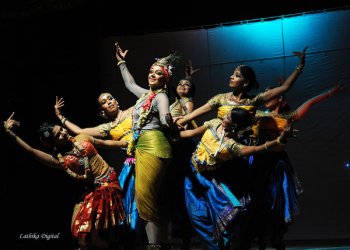
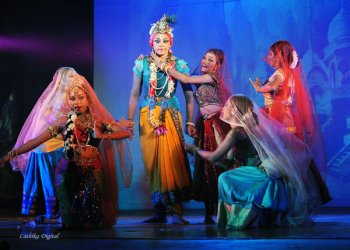
The ‘dialogue drama’ as the artiste calls it, is cast in English, voice given by a host of celebrities from filmdom - Arjun by Surya, Gandhari by Shabana Azmi, Radha by Konkana Sen and Draupadi by Nandita Das. The sound is designed by Resul Pookutty, the grand musical surges with prerecorded music, classical as well as Indian filmy strains. The living legend of Krishna moves through the journey of his life pausing briefly at junctures and milestones. His lasting legacy that is still shaping the philosophy of life in India and love as a value that transcends the physical, are the high points of the ballet. The screen, using computer technology, paints the backdrop as the scenes pass through Gokul, Vrindavan, Mathura, Kurukshetra and Dwaraka. Krishna’s multi-dimensional personality emerges from his birth in prison in the mystery of darkness, growth as a foster child in Gokul, his youth as a shepherd boy in Vrindavan flirting with gopis, the test of his strength and character in Mathura, his love and romance, his efforts for peace amidst war mongering princes, his philosophy as a General in the battle field and the finale of his exit. Krishna is embedded in Indian consciousness. He cannot be explored in his entirety in a single effort. The two and half hour dance drama is a dancer’s interpretation of Krishna, a universal icon celebrated in Indian arts: the enduring legacy he left behind as a man, lover and philosopher. The choreography was a mix of classical, folk and cinematic dance forms. According to Shobana, “It is a coming together of discipline and artistry into a parade of vital pulsing talent of 15 to 18 performers.” The human angle of the dancing god is special in this creation. The frolicking days of Gokul deepens into friendships with romantic nuances in Vrindavan and into a companionship with Radha. When the Dwaraka sojourn begins, Krishna asks Radha to accompany him. It is Radha who decides to remain at home. Relentless life sweeps Krishna away. Radha is the keeper of his flute now. Krishna loses both his love and the music of his passionate youth. The inexorable life brings him Rukmini, other diplomatic marriages. The depiction of Krishna’s tender closeness to Sudama is juxtaposed with his enduring love for Radha. Radha remains Krishna’s true love inhabiting his mental plane in spite of what life has forced on him. Draupadi’s love for Krishna is another facet. Physical attraction for Krishna may be the initial spinner. But Draupadi’s love is sublimated and Krishna, her great friend, reaches her when she needs him. Such sublimated love with a spiritual aura is truly human as the stories of many women in history records. 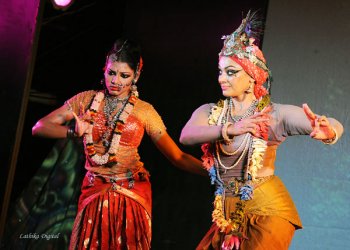 Shobana and group
Peace was Krishna’s mission. Accepting life with one’s sense of dharma was his philosophy. So, when he failed in diplomatic missions, Krishna masterminded strategies to face the inevitable. At the end of the war, Gandhari took him to task. Knowing how he failed her, how he failed himself, Krishna remained silent. Gandhari’s curse took its toll: the deluge swallowed Dwaraka and the Yadavas. Killed by a hunter, Krishna makes his exit as an incarnation. Krishna’s legacy, the Gitopadesam, is staged as the memory of Arjuna replaying the invaluable lesson he learned at Kurukshetra, and the Viswaroopa Darsanam as something imprinted in his mind. The show that began with a woman wailing for her lover is rounded off with the same scene, as if the Earth, in deep trauma, laments the loss of her lover. Love of Radha reaches its mystic heights. The battle scenes of Shobana are cast in satirical vein. Clad in black, some wearing masks and goggles that looked like masks were parodying battle. They looked like scarecrows jumping up and down in folk numbers to frenzied tempo of music. The legacy of the Gita was brought to the end of the drama from the battlefield. Had a booming male voice cast the words, it would have been in tune with the legacy of Krishna. Lyrics in English set to classical ragas are a novelty, but somehow it failed to gel, and other languages like Malayalam, Tamil, Hindi etc, mark their presence. The exit of Krishna in a yogic pose would have added a shade more to the divine incarnation. Aesthetic costumes added a symbolic dimension. Coordination spoke of practice. The drama reiterated eternal values like love, faith, devotion and enlightenment. Peace was a dominant recurring theme. Those who had watched Shobana’s classical dance performances expected more. For them the show seemed more cinematic, hence a disappointment. In Kerala, there is a vegetarian dish called avial where all the home-grown vegetables mark their presence in different proportions. I was reminded of the Kerala avial. The mega stage show that catered to contemporary needs was a success like many of our movies. But the grandeur and magnificence of classics is something unique by itself. Subsequently when, as part of the Soorya Fest, Bharatanatyam exponent Alarmel Valli performed, art reached the heights of aesthetics. 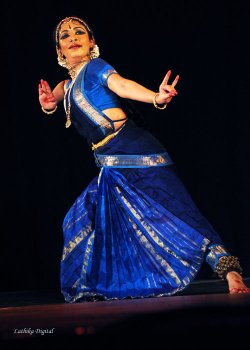 Alarmel Valli Alarmel Valli is a unique dancer with a distinctive style. Age has not withered her nor has time dulled her infinite charm as a dancer. Like a young maiden she moves and darts in deer like liveliness. The impact of her recital is the partaking of her infectious joy and enthusiasm, which is the special gift of the artiste. In tune with the Soorya Festival, Valli performed her invocation to the Sun, the primordial god, supreme light, the source of power and energy. Culled from different sources, like Kamba Ramayanam and classical Sanskrit verses, ‘Adityaya Namasthubhyam…’ set to Ragamalika celebrates the celestial glory of the sun. Bathed in the light of dawn, the silhouette of the dancer emerges. The sun ascends sprinkling vermilion, stirring life. Glowing in harmony it spreads - petals unfurl, flowers bloom, the winged world flutter and chirp. The sun god Soorya in his blazing chariot rides onto an idyllic world. The glory of the sun suffuses the animate, mundane world. It was as if we reached a lost world, ages ago when humanity worshiped the sun in its temples, the days when temples like the Konark were built. Swept by an unearthly brilliance, the audience entered a realm where music, dance and light coalesced to give another world away from our ordinary perceptions. Music was composed by Prema Ramamoorthy and Latha Ramchand. 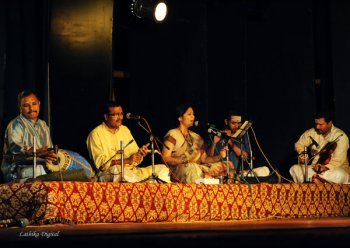 Alarmel Valli’s music ensemble After the invocation, Valli introduced her orchestra, the spirit that moves her dancing body into a rhythmic chant. Together they wove a magic spell. The golden voice of Preethi Mahesh competed with nattuvangam of C.K. Vasudevan that ranged from husky to loud tones. Flute by Sruthi Sagar opened on to a charmed land, where violin by Venkatasubramaniam highlighted the mridangam of the much sought after Saktivel Muruganandam. Lighting by Gandhi enhanced the nuances. The rare chemistry between the sensitive orchestra and the dancing nymph was the soul and spirit of Valli’s enchantment. She introduced her second item, a varnam, as if she painted the scene. The nature motif from the invocation continued giving an organic unity to the recital. Jointly composed by Prema Ramamoorthy and Alarmel Valli in Ragamalika, the varnam presented the cosmic dancer enshrined in the magnificent temple at Chidambaram where Siva is worshipped as the Lord of Dance. As the heroine longs for the closeness of her lord, the line between the sacred and sensual blurs and in its haziness passion dissolves into devotion. The dancer melts into the cosmic dance. Everywhere she sees her Lord. Amidst the dark rain clouds where shafts of lightning criss-cross she glimpses her Lord. For her, Neelakanta comes into view as gods and demons churn the primordial ocean. Love and blessing descend in the pitter patter of rains. The thrill, physical in its essence, overwhelms her. Then it pours. Lotuses and lilies blossom, waterfalls swell, rivers surge, waves rise, the land is drenched. Life springs everywhere. Spring weaves its magic. Lord Nataraja surveys his land from the lofty towers of the glorious temple. All is right with the world. The heroine sends her friend to bring her Lord to her. The twin threads of the mystical and the sensual are interwoven in the tapestry of Indian aesthetics and in Valli’s interpretation of this traditional piece. If love is divine and joyous, the third item depicted its dark side, the pain it casts. The poem is taken from the Tamil literature of Sangam period. The heroine is presented as the very picture of desolation. Here nature is not just a backdrop, but as expressive as the character and it mirrors the mood of the heroine. The silvery light paints a cold, desolate, wintry night where a lone woman lost in a bleak world keeps vigil for her husband, a philanderer. The long heavy silence of the night is broken by the tinkling of a bell. She listens in vain. It comes from the bell around the neck of a bull from the cowshed in the yard. The sound deepens her loneliness. The buzzing of the insect becomes a metaphor for the woman’s mental anguish. The misery of the winter night evokes the misery of her mental landscape in its isolation. Light fades off. Darkness envelops. Somewhere in the early hours of the dawn her husband returns with the usual excuses. He faces a woman who rages in sarcasm. What hypocrisy? What forgiveness after such infidelity? There is only pain at his deception and anger at his pretense. ‘Don’t you dare to touch me!’ The piece ends in a raging silent storm, in one gesture, in very few words. Nritta Lahari, the concluding item in ragam Hamsanadam was a mesmerizing pure dance number from whence music and poetry gushed to drench the audience in joy. The thrill of the rain in the varnam returned in a cloud burst, seemed to penetrate deep into the mind, giving rise to pure joy… Then the spell broke. Outside, the October rains drenched the night. We waited in silence for the rain to stop and to still the excitement long after the dance was over. Padma Jayaraj is a freelance writer on the Arts and travel and is a regular contributor to www.narthaki.com. |